Built 1901 LAHCM # 4 Opened 1901 Added to NRHP 13 October 2000 | NRHP Reference # 00001168 Designated LAHCM August 6, 1962 | |
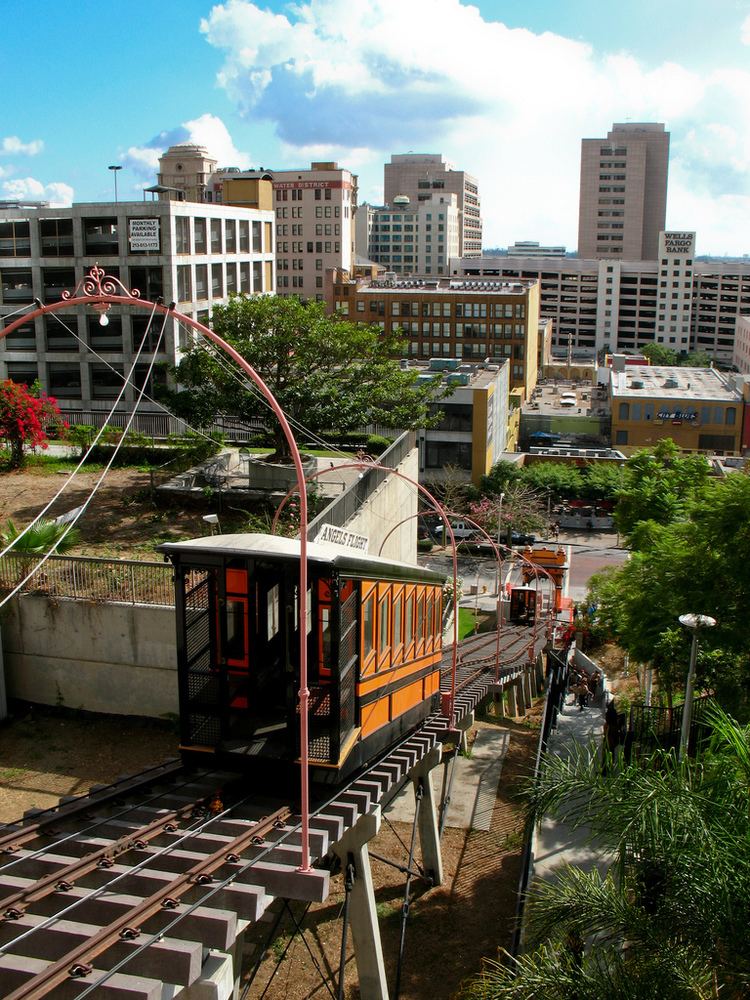 | ||
Similar Homer Laughlin Building, Bradbury Building, Watts Towers, Million Dollar Theater, Los Angeles City Hall | ||
Angels Flight (or Angels's Flight) is a landmark 2 ft 6 in (762 mm) narrow gauge funicular railway in the Bunker Hill district of Downtown Los Angeles, California. It has two funicular cars, Sinai and Olivet, running in opposite directions on a shared cable on the 298 feet (91 m) long inclined railway.
Contents
- Hd angels flight railway downtown los angeles
- The original Angels Flight
- Dismantling
- Reconstruction
- 2001 accident
- Evaluation
- Repaired
- Reopening and temporary closing
- 2013 accident
- Art
- Film and video
- Literature
- Music
- Games
- References
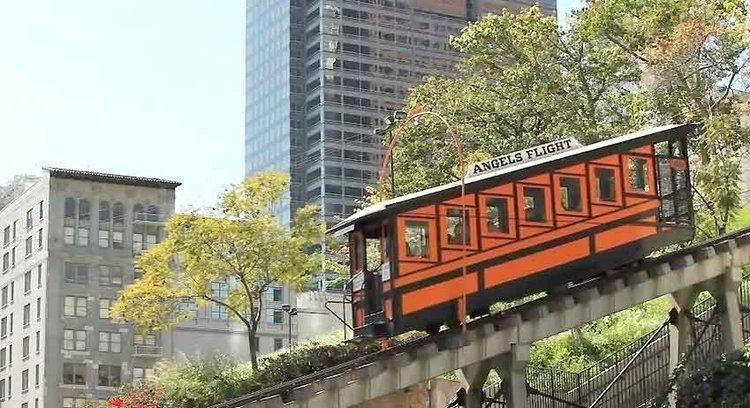
The funicular has operated on two different sites, using the same cars and station elements. The original Angels Flight location, with tracks connecting Hill Street and Olive Street, operated from 1901 until it was closed in 1969, when its site was cleared for redevelopment.
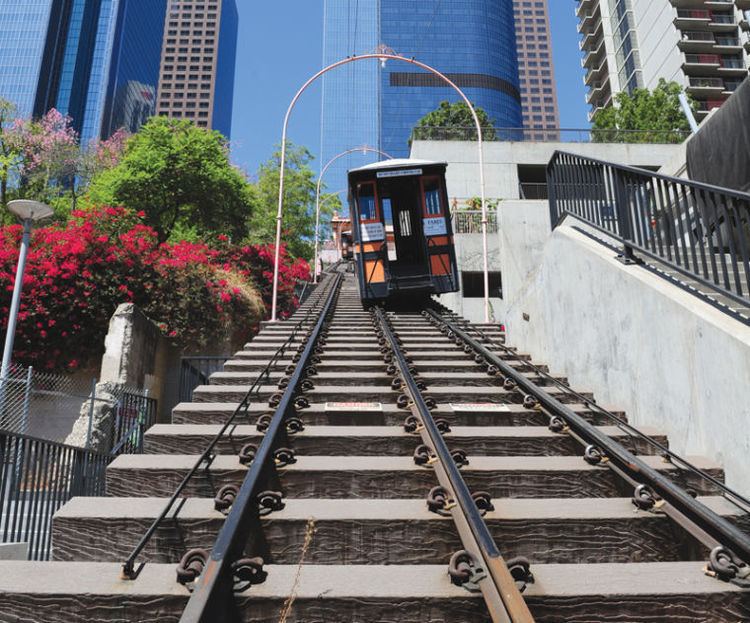
The second Angels Flight location opened two blocks south in 1996, with tracks connecting Hill Street and California Plaza. It was re-closed in 2001, after a fatal accident, and took nine years to commence operations again, on March 15, 2010. It was closed again from June 10, 2011, to July 5, 2011, and then again after a minor incident on September 5, 2013. The investigation of this 2013 incident led to the discovery of potentially serious safety problems in both the design and the operation of the funicular, and Angels Flight service has been suspended since that time with no timetable for restored service. Before the 2013 service suspension, the cost of a one-way ride was 50 cents (25 cents for Metro pass holders).
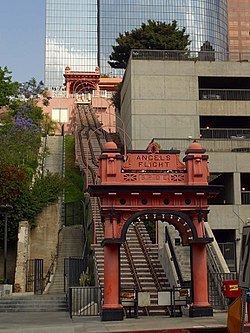
Although it was marketed primarily as a tourist novelty, it was frequently used by local workers to travel between the Downtown Historic Core and Bunker Hill. In 2015, the executive director of the nearby REDCAT arts centre described the railroad as an important "economic link", and there was pressure for the city to fund and re-open the railroad.
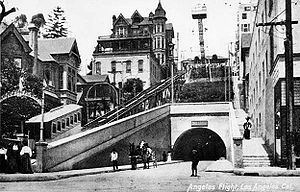
Hd angels flight railway downtown los angeles
The original Angels Flight
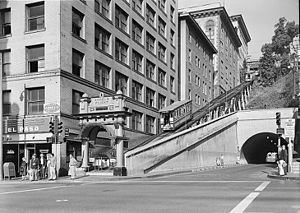
Built in 1901 with financing from Colonel J.W. Eddy, as the Los Angeles Incline Railway, Angels Flight began at the west corner of Hill Street at Third and ran for two blocks uphill (northwestward) to its Olive Street terminus. Angels Flight consisted of two vermillion "boarding stations" and two cars, named Sinai and Olivet, pulled up the steep incline by metal cables powered by engines at the upper Olive Street station. As one car ascended, the other descended, carried down by gravity. An archway labeled "Angels Flight" greeted passengers on the Hill Street entrance, and this name became the official name of the railway in 1912 when the Funding Company of California purchased the railway from its founders.
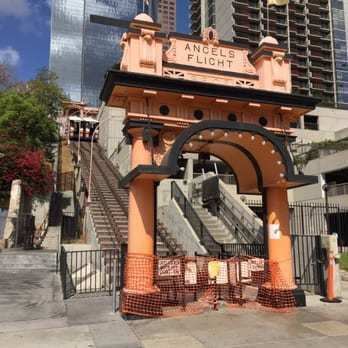
The original Angels Flight was a conventional funicular, with both cars connected to the same haulage cable. Unlike more modern funiculars it did not have track brakes for use in the event of cable breakage, but it did have a separate safety cable which would come into play in case of breakage of the main cable. It operated for 68 years with a good safety record.
The only fatality that involved the original Angels Flight occurred in the autumn of 1943, when a sailor attempting to walk up the track itself was crushed beneath one of the cars.
In November 1952, the Beverly Hills Parlor of the Native Daughters of the Golden West erected a plaque to commemorate fifty years of service by the railway.
The plaque reads:— Built in 1901 by Colonel J.W. Eddy, lawyer, engineer and friend of President Abraham Lincoln, Angels Flight is said to be the world's shortest incorporated railway. The counterbalanced cars, controlled by cables, travel a 33 percent grade for 315 feet. It is estimated that Angels Flight has carried more passengers per mile than any other railway in the world, over a hundred million in its first fifty years. This incline railway is a public utility operating under a franchise granted by the City of Los Angeles. —
In 1962, at its first meeting, the city's new Cultural Heritage Board designated Angels Flight a Los Angeles Historic-Cultural Monument (No. 4), along with four other locations. Los Angeles was early in enacting preservation laws, and the first sites chosen each were "considered threatened to some extent," according to the history of the board, now the Cultural Heritage Commission.
Dismantling
The railway was closed on May 18, 1969 when the Bunker Hill area underwent a controversial total redevelopment which destroyed and displaced a community of almost 22,000 working-class families renting rooms in architecturally significant but run-down buildings, to a modern mixed-use district of high-rise commercial buildings and modern apartment and condominium complexes. Both of the Angels Flight Cars, Sinai and Olivet were then placed in storage at 1200 S. Olive Street, Los Angeles. This was the location of Sid and Linda Kastner's United Business Interiors. At this location the Kastners maintained a private museum "The Bandstand". The Bandstand featured Antique Coin Operated Musical Instruments where one of the cars (Sinai) was on display in the museum. Olivet was stored in the garage of the building. They were stored at this location for 27 years at no charge in anticipation of the railway's restoration and reopening.
Reconstruction
After being stored for 27 years, the funicular was rebuilt and reopened on February 24, 1996, half a block south of the original site. Although the original cars, Sinai and Olivet, were used, a new track and haulage system was designed and built, a redesign which had unfortunate consequences five years later. As rebuilt, the funicular was 91 meters (298.6 feet) long on an approximately 33-percent grade.
Car movement was controlled by an operator inside the upper station house, who was responsible for visually determining that the track and vehicles were clear for movement, closing the platform gates, starting the cars moving, monitoring the operation of the funicular cars, observing car stops at both stations, and collecting fares from passengers. The cars themselves did not carry any staff members. Angels Flight was added to the National Register of Historic Places on October 13, 2000.
2001 accident
On February 1, 2001, Angels Flight had a serious accident that killed a passenger, Leon Praport (age 83), and injured seven others, including Praport's wife, Lola. The accident occurred when car Sinai, approaching the upper station, reversed direction and accelerated downhill in an uncontrolled fashion to strike car Olivet near the lower terminus.
The National Transportation Safety Board (NTSB) conducted an investigation into the accident and determined that the probable cause was the improper design and construction of the Angels Flight funicular drive and the failure of the various regulatory bodies to ensure that the railway system conformed to initial safety design specifications and known funicular safety standards. The NTSB further remarked that the company that designed and built the drive, control, braking, and haul systems, Lift Engineering/Yantrak, is no longer in business and that the whereabouts of the company's principal is unknown.
Unlike the original, the new funicular used two separate haulage systems (one for each car), with the two systems connected to each other, the drive motor, and the service brake by a gear train; it was the failure of this gear train that was the immediate cause of the accident since it effectively disconnected Sinai both from Olivet’s balancing load and from the service brake. There were emergency brakes that acted on the rim of each haulage drum, but due to inadequate maintenance, the emergency brakes for both cars were inoperative, which left Sinai without any brakes once its physical connection to the service brake was lost. Contrary to what might be expected, the new funicular was constructed with neither safety cable nor track brakes, either of which would have prevented the accident; the NTSB was unable to identify another funicular worldwide that operated without either of these safety features.
Records indicate that the emergency brake had been inoperative for 17 to 26 months due to the fact that a normally closed hydraulic solenoid valve had been placed in a location where the design called for a normally open valve and that its ill fitted solenoid was burned out.
During the 17 to 26 months that the emergency braking system was not operating, the braking system was tested daily, but since the service brake and emergency brake were tested simultaneously, there was no way to tell if the emergency brake was functioning without looking at the brake pads or hydraulic pressure gauges during the test. The test was always performed with the Sinai car traveling uphill, which meant that when the power was cut and the brakes applied (as part of the test), Sinai’s momentum caused the car to continue moving uphill a short distance (slackening the cable) and then to roll back from gravity, jerking the cable tight.
If the emergency brakes had been functional, they would have caught Sinai when the cable snapped tight, but without the emergency brakes, the force of the jerk caused by the daily test was directed through the spline (the part that failed) and to the service brake. In addition, it was found that the original design called for the spline to be made of AISI 1018 steel on one drawing and of AISI 8822 steel on a different drawing, but it is unlikely that this ambiguity in the design contributed to the accident. However, regular analysis of gear box oil-samples was discontinued in May 1998, despite the fact that the company performing the tests recommending that the rising particulate level in the oil samples warranted the test occurring more frequently. The continued rising particulate level may have been in part caused by unusual wear of the splines. Continued testing could have resulted in an inspection to locate the cause of the unusual wear.
Besides the design failures in the haulage system, the system was also criticised by the NTSB for the lack of gates on the cars and the absence of a parallel walkway for emergency evacuation. The funicular suffered serious damage in the accident.
Evaluation
The death and injuries could have been avoided if any one of the following had taken place:
Repaired
On November 1, 2008, both of the repaired and restored Angels Flight cars, Sinai and Olivet, were put back on their tracks and, on January 16, 2009, testing began on the railway. On November 20, 2009, another step in the approval process was achieved. On March 10, 2010, the California Public Utilities Commission approved the safety certificate for the railroad to begin operating again.
The new drive and safety system completely replaced the system which was the cause of the fatal 2001 accident. Like the original Angels Flight design and most traditional funicular systems, the new drive system incorporates a single main haulage cable, with one car attached to each end. Also like the original design, a second safety cable is utilized. To further enhance safety, unlike the original design, each car now has a rail brake system, as a backup to the main backup emergency brakes on each bull-wheel. Another added safety feature is an independent evacuation motor to move the cars should the main motor fail for any reason.
Reopening and temporary closing
Angels Flight reopened to the public for riding on March 15, 2010. The local media covered the event with positive interest. Only a month after re-opening, Angels Flight had had over 59,000 riders. It connected the Historic Core and Broadway commercial district with the hilltop Bunker Hill California Plaza urban park and the Museum of Contemporary Art - MOCA. The cost of a one-way ride at that time was 50 cents, 25 cents with TAP card.
On June 10, 2011, the California Public Utilities Commission ordered Angels Flight to immediately cease operations due to wear on the steel wheels on the two cars. Inspectors determined that their fifteen-year-old wheels needed replacing. It reopened on July 5, 2011, after eight new custom-made steel wheels were installed on the two cars.
2013 accident
On September 5, 2013, one car derailed near the middle of the guideway. One passenger was on board the derailed car, and five passengers were on board the other car. There were no injuries. Passengers had to be rescued from the cars by firefighters. The brake safety system had been bypassed with a small tree branch.
The National Transportation Safety Board determines the probable cause of the September 5, 2013, accident was the intentional bypass of the funicular safety system with Angels Flight management knowledge; and Angels Flight management continuation of revenue operations despite prolonged, and repeated, unidentified system safety shutdowns.
The NTSB also noted a problem with the basic design: "The car body and the wheel-axle assembly are not articulated." The passing section of the track involves a short turning section which allows the cars to pass each other. The axles do not turn to follow the track, resulting in the wheel flanges grinding against the rail, causing excessive wheel wear. This problem, combined with safety system problems which caused unwanted track brake deployment, resulted in a derailment. Angels Flight remains closed pending resolution of all these problems.
